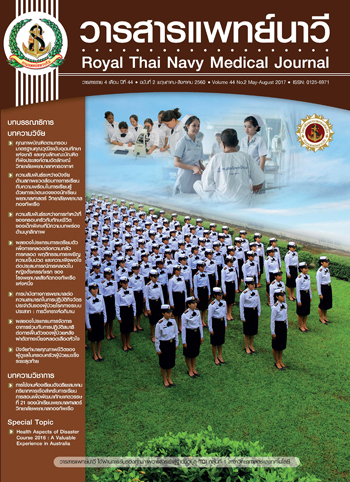Effect of Childbirth Preparation on Fear of Childbirth, Labor Pain Coping Behaviors, and Satisfaction with Childbirth Experience in Primiparous at a Hospital under the Jurisdiction of Royal Thai Navy
Main Article Content
Abstract
This quasi pretest– posttest control group design experimental research consisting
of two groups was aimed to determine the effects of childbirth preparation on fear of childbirth,
labor pain coping behaviors, and satisfaction with childbirth experiences of primiparous who
visited the antenatal unit and clinical obstetrics unit and gave birth at Somdejpranangchaosirikit
Hospital. The sample was selected by purposive sampling technique and equally
assigned into either a control or experimental group of 26 participants each. Participants in the
control group received routine nursing care, while those in the experimental group received a
childbirth preparation program. The research was conducted in a group at Somdejpranangchaosirikit
Hospital delivery room. Research instruments included Childbirth preparation
Program and Instruments used for data collection were a fear of childbirth questionnaire
(Cronbach’s alpha coefficient = .81), a labor pain coping behavior observation form
(inter-rater reliability = .93), and a Childbirth experience and satisfaction questionnaire (a
labor agentry Scale) (Cronbach’s alpha coefficient = .81). Data were analyzed by descriptive
statistics and t - test.
Results revealed significantly less fear of childbirth mean score (α = .05, t50 = -35.02,
p < .001), significantly higher labor pain coping behavior mean scores (α = .05, t50 = 5.11,
p < .001), and significantly higher satisfaction with childbirth experience mean score (α = .05, t50
= 18.67, p < .001), of those in the experimental group than the control group.
The finding in this study suggests that the childbirth preparation program could reduce
fears of labor pain, help pregnant women to control themselves and cope with the pain, and
perceive positive childbirth experiences. Application of this childbirth preparation should be
promoted for primiparous women.
Article Details

This work is licensed under a Creative Commons Attribution-NonCommercial-NoDerivatives 4.0 International License.
References
จิราพร วรวงศ์. ความรู้เบื้องต้นเกี่ยวกับการคลอด. ใน มณีภรณ์ โสมานุสรณ์, บรรณาธิการ. การพยาบาล สูติศาสตร์เล่ม 2 (1-6). นนทบุรี: ยุทธรินทร์การพิมพ์; 2553.
Melender HL. Fear and coping strategies associated with pregnancy and childbirth in Finland. J Midwifery Womens Health 2002;47(4):256-63.
สมภพ เรืองตระกูล. การตั้งครรภ์: โรคทางจิตและการรักษา. กรุงเทพมหานคร: เรือนแก้วการพิมพ์; 2550.
Körükcüa Ö, Firat MZ, Kukulu K. Relationship between fear of childbirth and anxiety among Turkish pregnant women. Procedia Social and Behavioral Sciences 2010;5:467-70.
Chuahorm U, Sripichyakarn K, Tungpunkom P, Klunklin A, Kennedy HP. Fear and Suffering During Childbirth Among Thai Women. Thai Journal of Nursing Research 2007;11(1):49-61.
Dick-Read G, Wesel H, Ellis HF. The Practice of Natural childbirth. New York: Harper & Row; 1976.
Simkin P. Just another day in a woman’s life? Women’s long-term perceptions of their first birth experience. Part I. Birth 1991;18(4):203-10.
Simkin P. Just another day in a woman’s life? Part II: Nature and consistency of women’s long-term memories of their first birth experiences. Birth 1992;19(2):64-81.
Wilkinson C, McIlwaine G, Boulton-Jones C, Cole S. Is a rising cesarean section rate inevitable? Br J Obstet Gynaecol 1998;105(1):45-52.
Ryding EL, Lukasse M, Parys AV, Wangel AM, Karro H, Kristjansdottir H, et al. Fear of childbirth and Risk of Cecarean Delivery: A Cohort Study in Six European Countries. Birth 2015;42(1):48-55.
WHO: Appropriate technology for birth. Lancet 1985;2(8452):436-7.
Vogel JP, Betrán AP, Vindevoghel N, Souza JP, Torloni MR, Zhang J, et al. Use of the Robson classification to assess caesarean section trends in 21 countries: a secondary analysis of two WHO multicountry surveys. Lancet Glob Health 2015;3(5):260-70.
เขตบริการสุขภาพที่ 6. ยุทธศาสตร์การพัฒนาระบบบริการ เขตบริการสุขภาพที่ 6 ปี 2558-2560. [อินเทอร์เน็ต]. [เข้าถึงเมื่อ 20 พฤษภาคม 2558]. แหล่งที่มา: https://www.region6.cbo.moph. go.th/yuttha.pdf.
Jeyrani MN, Zeidi BM, Malekzadegan A, Hossaini F. The effect of childbirth preparation classes on fear of childbirth and severity of labor pain in pregnant women reoffered to Akbarabady hospital of Tehran. Int J Gynecol Obstet 2008;107(2):284.
Consonni EB, Calderon IM, Consonni M, De Conti MH, Prevedel TTs, Rudge MV. A multidisciplinary program of preparation for childbirth and motherhood: maternal anxiety and perinatal outcomes. Reprod Health 2010;7:28.
Novak JC, Broom BL. Maternal and Childbearing Family Nursing. 8th ed. St.Louis: Mosby; 1995.
Dick-Read G. Childbirth without Fear. 5th ed. New York: Harper & Row; 1984.
McKinny ES, James SR, Murray SS, Ashwill JW. Pain Management for Childbirth. Maternal-Child Nursing. St. Louis: Elsevier; 2005.
Polit DF, Beck CT. Nursing Research: Principles and Methods. 7th ed. Philadelphia: Lippincott Williams & Wilkins; 2004.
บุญใจ ศรีสถิตย์นรากูร. ระเบียบวิธีวิจัยทางการพยาบาล. พิมพ์ครั้งที่ 5. กรุงเทพมหานคร: ยูแอนด์ไอ อินเตอร์ มีเดีย; 2553.
จิตตานันท์ ศรีสุวรรณ. ผลของการเตรียมคลอดโดยให้ครอบครัวมีส่วนร่วมต่อความรู้ความวิตกกังวล ระดับความเจ็บปวดและพฤติกรรมการเผชิญความเจ็บปวดของมารดาวัยรุ่นครรภ์แรก. [วิทยานิพนธ์ปริญญาพยาบาลศาสตรมหาบัณฑิต สาขาการพยาบาลครอบครัว]. มหาวิทยาลัยขอนแก่น; 2550.
Wijma K, Wijma B, Zar M. Psychometric aspects of the W-DEQ; a new questionnaire for the measurement of fear of childbirth. J Psychosom Obstet Gynaecol 1998;19(2):84-97.
Sturrock ELW. Evaluation of tools for describing patient responses to labor. [Master’s Thesis]. University of Utah; 1972.
ฉวี เบาทรวง, สุพิศ รุ่งเรืองศรี. ผลของการสัมผัสต่อการเผชิญความเจ็บปวดในระยะคลอดและการรับรู้ประสบการณ์การคลอด. พยาบาลสาร 2537;21(4):18-24.
Hodnett ED, Simmons-Tropea DA. The Labour Agentry Scale: psychometric properties of an instrument measuring control during childbirth. Res Nurs Health 1987;10(5):301-10.
Yuenyong S. Effect of a close female relative support during labour and delivery on duration of active labour, incidence of spontaneous delivery, and satisfaction with childbirth experience. [Doctoral dissertation]. Chulalongkorn University; 2007.
Yuenyong S, O’Brien B, Jirapeet V. Effects of labor support from close female relative on labor and maternal satisfaction in a Thai setting. J Obstet Gynecol Neonatal Nurs 2012;41(1):45-56.
Ip WY, Tang CS, Goggins WB. An educational intervention to improve women’s ability to cope with childbirth. J Clin Nurs 2009;18(15):2125-35.
กาญจนา ศรีสวัสดิ์. ผลของการให้ความรู้และฝึกผ่อนคลายต่อความตึงเครียดในหญิงตั้งครรภ์วัยรุ่น. พยาบาลสาร 2554;38(1):40-51.
Melzack R, Wall PD. Pain mechanisms: A new theory. Science 1965;150(3699):971-9.
รัชนันต์ ถิรรดา. ผลของการเตรียมตัวเพื่อการคลอดต่อความรู้เกี่ยวกับการคลอด พฤติกรรมการเผชิญความเจ็บปวดในระยะคลอด และความพึงพอใจต่อการใช้บริการคลอดของมารดาครรภ์แรก. วารสารคณะพยาบาลศาสตร์ มหาวิทยาลัยบูรพา 2548;13(3):10-22.
Marut JS, Mercer RT. Comparison of primiparas’ perceptions of vaginal and cesarean births. Nurs Res 1979;28(5):260-6.
นวพร มามาก. ผลของโปรแกรมการส่งเสริมการมีส่วนร่วมของสามีในระหว่างการตั้งครรภ์และการคลอดต่อสัมพันธภาพระหว่างคู่สมรส การรับรู้ประสบการณ์การคลอดของมารดาและความรักใคร่ผูกพันระหว่างบิดามารดาและทารก. รามาธิบดีพยาบาลสาร 2551;4(2):258-72.
ศิวพร สุดเพชร, นันทนา ธนาโนวรรณ, ฉวีวรรณ อยู่สำราญ, ชานนท์ เนื่องตัน. ผลของโปรแกรมการสนับสนุนโดยสามีในระยะที่ 1 ของการคลอดต่อความเครียด ความเจ็บปวด และความพึงพอใจต่อการคลอดในผู้คลอดครรภ์แรก. วารสารสภาการพยาบาล 2557;29(3):42-54.

